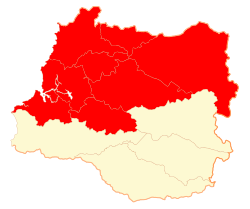Valdivia Province
The Valdivia Province (Spanish: Provincia de Valdivia) is one of the two provinces in the Chilean region of Los Ríos (XIV). The capital of the province, and of the region, is the city of Valdivia.
|
Provincia de Valdivia | |
|---|---|
| Coordinates: 39°45′S 72°30′W / 39.750°S 72.500°WCoordinates: 39°45′S 72°30′W / 39.750°S 72.500°W | |
| Country | |
| Region | Los Ríos |
| Capital | Valdivia |
| Comunas | See list |
| Government | |
| • Type | Provincial |
| • Governor | Patricia Morano Büchner[1] |
| Area | |
| • Total | 10,197.2 km2 (3,937.2 sq mi) |
| Population (2002 Census)[2] | |
| • Total | 259,243 |
| • Density | 25.42296/km2 (65.8452/sq mi) |
| Time zone | UTC-4 (CLT) |
| • Summer (DST) | UTC-3 (CLST) |
| Website | Government of Valdivia |
Geography
The Valdivia province is in the northern half of the Los Ríos region with an area of 10,197.2 sq mi (26,411 km2).[2] The capital, Valdivia, is in the western part of the province.
Valdivia is bordered to the north by the Cautín province (La Araucanía region), to the east by Argentina, to the south by the El Ranco province and to the west by the Pacific Ocean.
The main river in the province is the Valdivia river.
Climate
The climate of the Valdivia province, in the city of Valdivia, is an oceanic climate, Cfb (Marine West Coast Climate) in the Köppen climate classification.
The average temperature for the year in Valdivia is 12.3 °C (54.1 °F). The warmest month, on average, is January with an average temperature of 17 °C (63 °F). The coolest month on average is July, with an average temperature of 8 °C (46 °F).
The average amount of precipitation for the year in Valdivia is 2,489 mm (98.0 in). The month with the most precipitation on average is June with 414 mm (16.3 in) of precipitation. The month with the least precipitation on average is January with an average of 65 mm (2.6 in).[3]
Population
As of 2002[update] (last national census), there were 259,243 people living in the province, giving it a population density of 25.4 inhabitants/km².[2] The urban population was 192,066 persons (74% of the total population).
The largest city of the province, in 2002, is its capital, Valdivia, with 127,750 inhabitants.
Administration
As a province, Valdivia is a second-level administrative division, consisting of 8 communes (comunas). The city of Valdivia serves as the provincial capital. The province is administered by a governor.
| Code | Comuna | Capital | Area[2] (km²) |
Population[2] (2002) |
Density |
|---|---|---|---|---|---|
| 14101 | Valdivia | Valdivia | 1,015.6 | 140,559 | 138.4 |
| 14102 | Corral | Corral | 766.7 | 5,463 | 7.1 |
| 14103 | Lanco | Lanco | 532.4 | 15,107 | 28.4 |
| 14104 | Los Lagos | Los Lagos | 1,791.2 | 20,168 | 11.3 |
| 14105 | Máfil | Máfil | 582.7 | 7,213 | 12.4 |
| 14106 | Mariquina | Mariquina | 1,320.5 | 18,223 | 13.8 |
| 14107 | Paillaco | Paillaco | 896.0 | 19,237 | 21.5 |
| 14108 | Panguipulli | Panguipulli | 3,292.1 | 33,273 | 10.1 |
| Total of Valdivia province | 10,197.2 | 259,243 | 25.4 | ||
Related pages
References
- ↑ "Conozca a la Gobernadora" (in español). Gobernación Provincial de Valdivia. Retrieved 15 October 2017.
- ↑ 2.0 2.1 2.2 2.3 2.4 2.5 "Región de Los Ríos" (PDF). Instituto Nacional de Estadísticas. 2007. Archived from the original (PDF) on 20 May 2017. Retrieved 15 October 2017.
- ↑ "Valdivia Climate & Temperature". Climatemps.com. Retrieved 16 October 2017.
Other websites
- Territorial division of Chile (in Spanish)
- Gobierno Regional de Los Ríos Official website (in Spanish)
- Province of Valdivia website (in Spanish)


